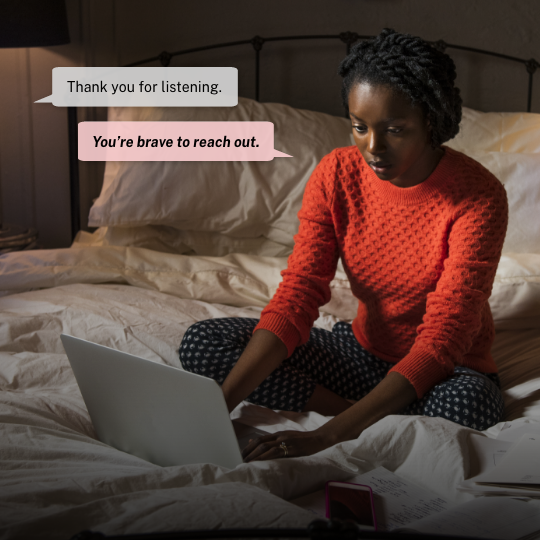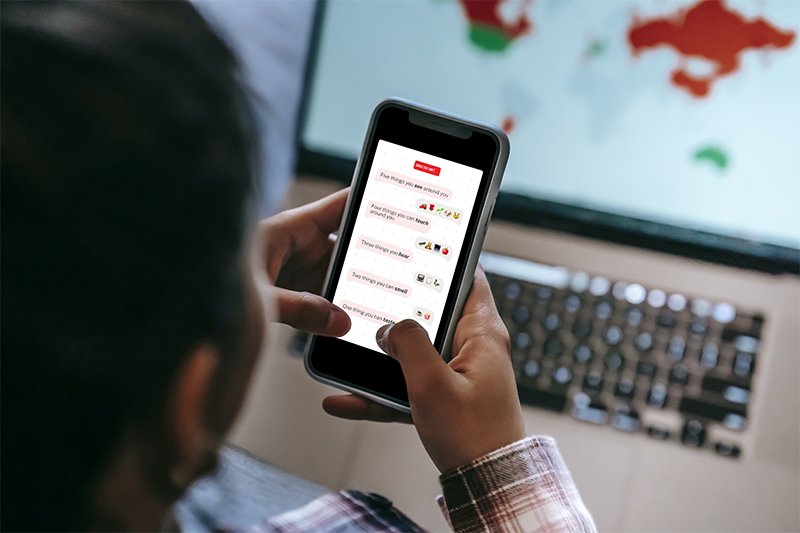At Crisis Text Line–Your Safety is Our Highest Priority

Taking that first step of reaching out for help can be the hardest and bravest thing you ever do. We want you to know that you are in good hands. Through empathetic and compassionate listening, Crisis Text Line volunteer Crisis Counselors and clinical supervisors are here to support you confidentially during your time of need.
We understand that it might be difficult sometimes to share your feelings especially with this question in mind: “Is Crisis Text Line going to contact emergency services if I share my thoughts and emotions?” The short answer is, almost always, no. We believe you are the expert of your own life, and we want to support you making decisions to keep you safe. In instances where you’re thinking about suicide, we’ll explore those thoughts with you and work together to create a plan for you to stay safe. We believe that by reaching out to a crisis service, you are asking for help, which indicates your strength and openness to finding an alternative to ending your life. However, if you do have a plan to end your life and are unable to agree to stay safe, our professional clinicians may need to act on your behalf to keep you from following through with the plan and getting the immediate support you deserve.

Crisis Text Line is committed to helping to further the critical expansion of on-the-ground support like mobile crisis units—which is a service that sends a mental health crisis worker and paramedics, rather than police—to people who are at imminent risk to themselves or others. Unfortunately, as a nation, we have a long way to go before we will see enough of these units deployed in every city and town to help people in crisis. When our clinical supervisors have exhausted all options and made the determination that life is at imminent risk, we work with local dispatch to ensure they understand we are dealing with a mental health crisis so that they can send the most appropriate support available, which can range from ambulance to fire, police trained for mental health intervention and in some communities, mobile crisis units. You matter, it is our goal to ensure you get the support that you need.
In rare instances, when we believe your life is at risk, our mental health staff at Crisis Text Line will initiate what we refer to as an Active Rescue. An Active Rescue is the practice of working with local emergency services to send support to a texter’s location if the texter is at imminent risk to themselves or others and cannot or will not stay safe without emergency intervention. Our clinical supervisors work with local emergency services because we do not have access to a texter’s location. We pass the information to emergency services and they follow their internal policies on locating people in need of immediate support. It is important to note that Crisis Text Line does not have the ability to geolocate texters. This authority remains solely with Public Safety Access Points (or “PSAPs”) which engage law enforcement and/or first responders.
We take situations involving Active Rescues very seriously and handle them with the utmost care and concern. Our top priority is always helping people in crisis stay safe. We only contact emergency services as a last resort which is usually in less than 1% of our conversations. We deeply understand that engaging law enforcement can be a risk, particularly for the BIPOC community. Centuries of systemic racism, cultural issues, and treating mental illness as a crime have created unequal systems and institutions that exist today. This is why we take this issue very seriously, and why we have explicit policies for Active Rescues that are aligned with common practices in the crisis intervention field.

At Crisis Text Line, we strive to be open and transparent with you. This is why we would like to provide you with an example of our Active Rescue protocol pertaining to suicide prevention. Below is a step-by-step process from the initial connection to initiating an Active Rescue:
- The initial connection. A texter reaches out to 741741 and receives an automated message asking about your crisis. Then, we use an algorithm to triage based on risk. On average, our texters who indicate a high risk for suicide connect with a Crisis Counselor in less than one minute.
- You are in control. When a texter connects with us, their Crisis Counselor will help the texter sort through their feelings by asking questions, empathizing, and actively listening. In the beginning phase of the conversation, the Crisis Counselor will also ask questions to assess the risk of suicide. You are in control of what you share with the Crisis Counselor as we are here for you without judgment.
- Collaborating for safety. In conversations where the texter indicates risk factors that put them at imminent risk of suicide, we work with the texter to come up with a safety plan. This can include working with the texter to remove their means intended to complete suicide. Sometimes it may include identifying a safe person in their life to reach out to so they can stay safe or exploring things in their life that make them feel calm. Since texters know their situation better than we do, we utilize a strength-based approach centering the texter in the conversation. Our goal is to do our best to discover and empower texters to find their own strength to help them stay safe. We also have a database of vetted and trusted resources for someone who is looking for new coping skills.
- Ensuring safety. In the rare cases that a texter cannot stay safe, our clinical supervisors will use their training, experience and discretion to determine that life is at imminent risk and we need to initiate an Active Rescue for the texter in crisis. Our clinical supervisors, who oversee all texter conversations, only initiate active rescues if they have reason to believe that a texter will go through with their plan to end their life. Since safety is our top priority, we share the necessary information with 911 to allow them to dispatch the most appropriate available emergency services in time to save a life.
- Initiating an active rescue. If our clinical supervisors initiates an active rescue to ensure a texter’s safety, they will use the texter’s phone number and phone carrier to contact a local 911 center and collaborate with first responders to get the most appropriate available help to the person in crisis.
We hope the narrative above has shed some light into our Active Rescue protocol. Remember, our ultimate goal is to keep people safe. Usually, that’s by helping a texter find a healthy coping strategy to work through their crisis. In some rare cases, that means collaborating to help the texter in crisis get help. As mentioned above, less than 1% of our conversations result in our needing to engage emergency services. That is only when our clinical supervisors have come to the determination that de-escalation is not possible and the texter is at imminent risk for ending their life or harming someone else.
We want you to know that we will always be here for you every minute of every day. Please don’t hesitate to connect with us by text, web chat or WhatsApp.
If you currently need support, please text HELLO to 741741 or 443-SUPPORT in WhatsApp to be connected to a live, trained volunteer Crisis Counselor or text HOLA to 741741 or 442-AYUDAME in WhatsApp for Spanish or connect with us via web chat.
